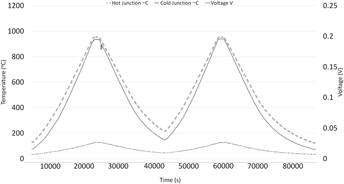Article contents
Novel temperature sensors for SiC–SiC CMC engine components
Published online by Cambridge University Press: 09 June 2017
Abstract

As more and more SiC–SiC ceramic matrix composites or CMC’s are being used in the hot sections of gas turbine engines, there is a greater need for surface temperature measurement in these harsh conditions. Thin film sensors are ideally suited for this task since they have very small thermal masses and are nonintrusive due to their thickness. However, if the bulk properties of SiC contributed to the sensor performance (thermoelectric response) rather than those of the thin films, superior resolution, and stability could be realized. Therefore, thermocouples utilizing the SiC–SiC CMC itself as one thermoelement and thin film platinum as the other thermoelement were developed. Large and stable thermoelectric powers (as large as 250 μV/°K) were realized with these Pt:SiC (CMC) thermocouples. The advantages in using this approach for surface temperature measurement are presented as well as the effects of fiber orientation on thermoelectric response and drift.
Keywords
- Type
- Invited Articles
- Information
- Journal of Materials Research , Volume 32 , Issue 17: Focus Issue: Achieving Superior Ceramics and Coating Properties through Innovative Processing , 14 September 2017 , pp. 3319 - 3325
- Copyright
- Copyright © Materials Research Society 2017
Footnotes
Contributing Editor: Eugene Medvedovski
References
REFERENCES
- 9
- Cited by





